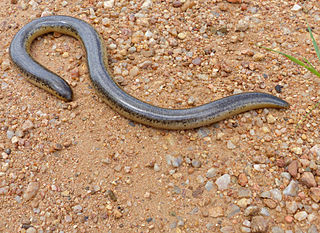
The Typhlopidae are a family of blind snakes. They are found mostly in the tropical regions of Africa, Asia, the Americas, and all mainland Australia and various islands. The rostral scale overhangs the mouth to form a shovel-like burrowing structure. They live underground in burrows, and since they have no use for vision, their eyes are mostly vestigial. They have light-detecting black eye spots, and teeth occur in the upper jaw. Typhlopids do not have dislocatable lower jaw articulations restricting them to prey smaller than their oral aperture. The tail ends with a horn-like scale. Most of these species are oviparous. Currently, 18 genera are recognized containing over 200 species.

The Leptotyphlopidae are a family of snakes found in North America, South America, Africa and Asia. All are fossorial and adapted to burrowing, feeding on ants and termites. Two subfamilies are recognized.
Xenotyphlops is a genus of snakes, the only genus of the family Xenotyphlopidae, comprising two species found only in Madagascar. These snakes are also known as the Malagasy blind snake.
Xenotyphlops grandidieri is a species of blind snake in the family Xenotyphlopidae. The species is endemic to Madagascar. There are no subspecies that are recognized as being valid.
Letheobia is a genus of blind snakes in the family Typhlopidae.

Epictia is a genus of snakes in the family Leptotyphlopidae. The genus is native to South America, Central America, and Mexico.
Bailey's blind snake is a species of snake in the family Leptotyphlopidae. The species is endemic to Ecuador.
The two-colored blind snake is a species of snake in the family Leptotyphlopidae. This species of snake are small, with a range usually between 15-20cm in length.
Tricheilostoma broadleyi is a species of snake in the family Leptotyphlopidae. The species is endemic to Ivory Coast.
Joshua's blind snake is a species of snake in the family Leptotyphlopidae. The species is endemic to Colombia.

Amaral's blind snake is a species of snake in the family Leptotyphlopidae. The species is native to South America.
Dugand's blind snake is a species of snake in the family Leptotyphlopidae. The species is endemic to South America.
The Santander blind snake is a species of snake in the family Leptotyphlopidae. The species is endemic to Colombia.
Sundevall's worm snake is a species of snake in the family Leptotyphlopidae. The species is endemic to Central Africa and West Africa.

The big-scaled blind snake is a species of snake in the family Leptotyphlopidae. The species is endemic to southern Central America and northern South America.
The Espírito Santo blind snake is a species of snake in the family Leptotyphlopidae. The species is endemic to Brazil.

Afrotyphlops is a genus of snakes in the family Typhlopidae.

Indotyphlops is a genus of snakes of the family Typhlopidae. The genus is endemic to Asia.

Trilepida is a genus of snakes in the family Leptotyphlopidae.

Myriopholis is a genus of snakes in the family Leptotyphlopidae. Most of the species were previously placed in the genus Leptotyphlops.







